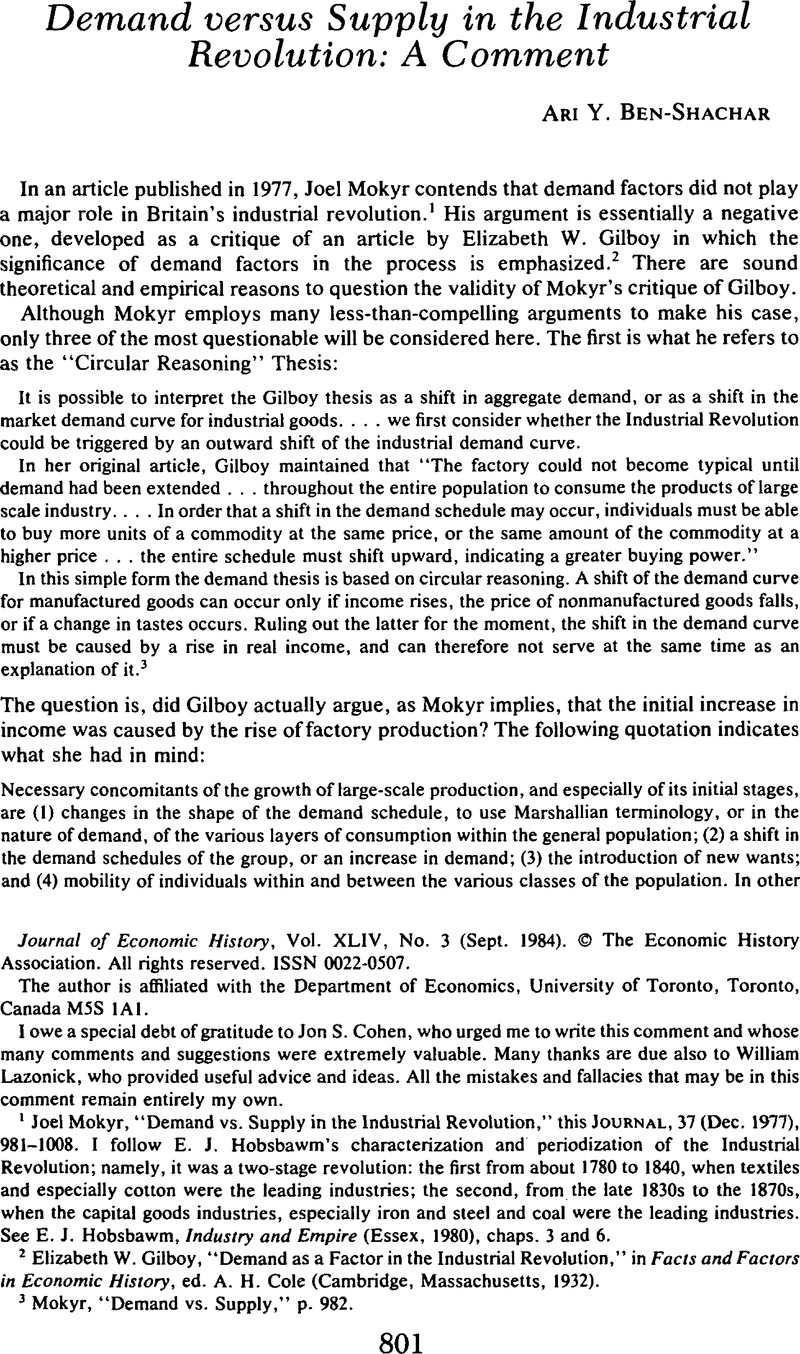Article contents
Demand versus Supply in the Industrial Revolution: A Comment
Published online by Cambridge University Press: 03 March 2009
Abstract

- Type
- Notes and discussion
- Information
- Copyright
- Copyright © The Economic History Association 1984
References
1 Mokyr, Joel, “Demand vs. Supply in the Industrial Revolution,” this JOURNAL, 37 (12. 1977), 981–1008. I follow E. J. Hobsbawm's characterization and penodization of the Industrial Revolution; namely, it was a two-stage revolution: the first from about 1780 to 1840, when textiles and especially cotton were the leading industries; the second, from the late 1830s to the 1870s, when the capital goods industries, especially iron and steel and coal were the leading industries.Google Scholar See Hobsbawm, E. J., Industry and Empire (Essex, 1980), chaps. 3 and 6.Google Scholar
2 Gilboy, Elizabeth W., “Demand as a Factor in the Industrial Revolution,” in Facts and Factors in Economic History, ed. Cole, A. H. (Cambridge, Massachusetts, 1932).Google Scholar
3 Mokyr, “Demand vs. Supply,” p. 982.Google Scholar
4 Gilboy, “Demand as a Factiory,” pp. 624–25.Google Scholar
5 Mokyr, “Demand vs. Supply,” pp. 982–83.Google Scholar
6 Ibid., p. 983, footnote 7.
7 Ibid.
8 See, for instance, Deane, Phyllis and Cole, W. A., British Economic Growth, 1688–1959 (Cambridge, 1962), Tables 35–37.Google Scholar
9 Ibid.
10 It should be added, however, that the average rate of growth of industrial output for the entire period (1750–1850) cannot “be estimated conservatively at 3% annually,” as Mokyr does. The correct estimates are almost 2 percent for the second half of the eighteenth century and almost 3 percent for only the first hall of the nineteenth century. These figures were calculated from Deane and Cole, British Economic Growth, Table 19;Google Scholar and Mitchell, B. R., Abstract of British Historical Statistics (Cambridge, 1971), p. 271.Google Scholar
11 It is interesting that in a latter section of his essay, Mokyr tries to dismiss the existence of unemployment in this period, contending that in preindustrial Europe there existed a barter economy (p. 1001). This argument, however, contradicts almost all his other arguments made throughout his essay that assume the existence of a highly competitive economy.
12 For a thorough treatment of this approach, see Reynolds, C. W., “Development Problems of an Export Economy,” in Essays on the Chilean Econony, ed. Reynolds, C. W. and Mamalakis, M. (Homewood, Illinois, 1965);Google Scholar and Rostow's, W. W. article on “The Take-Off into Self-Sustained Growth,” in The Economics of Underdevelopment, ed. Singh, Agarwala E. (Oxford, 1970).Google Scholar
13 Davies, R., The Industrial Revolution and British Overseas Trade (Leicester, 1979), Table 2.Google Scholar
14 Mokyr, “Demand vs. Supply,” p. 987.Google Scholar
15 Deane and Cole, British Economic Growth, Tables 42, 43.Google Scholar
16 The data was taken from Mitchell, Abstract, pp. 131, 146–48, 177–79, 182. The equations are of the form Yt = Xitβi + Ut, where Ut, = ρUt−1 + ∈t. Multicollinearity was checked and no evidence was found to support its existence. The Durbin two-step method of estimation was used to deal with serial correlation. Because the number of observations always exceeds 30, the Durbin h test was also used.Google Scholar For explanations, see Johnston, J., Econometric Models, 2nd ed. (Tokyo, 1972), p. 313.Google Scholar
17 Mokyr, “Demand vs. Supply,” p. 987.Google Scholar
18 For an interesting account of the place of comparative-static analysis in economic history, see North, Douglass C., “The New Economic History After Twenty Years,” American Behavioral Scientist, 21 (12. 1977), 187–200.CrossRefGoogle Scholar For an assessment of the role of the comparative-static method in analyzing economic development and economic growth, see Seers, D., “The Limitations of the Special Case,” in The Teaching of Development Economics, ed. Martin, K. and Knopp, E. J. (London, 1967).Google Scholar
- 4
- Cited by




